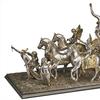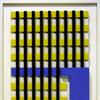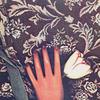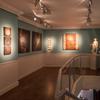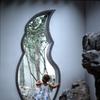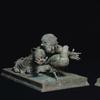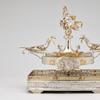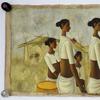'Rural Modern: American Art Beyond the City' Exhibition to Open at Brandywine
- CHADDS FORD, Pennsylvania
- /
- June 16, 2016
Rural Modern: American Art Beyond the City, a major new exhibition opening at the Brandywine River Museum of Art, will provide an innovative view of avant-garde art from the 1920s through 1950s, exploring the surprising contribution of artists working outside major urban centers to the expansion and acceptance of modernist styles in the United States. Modernism spread outward from New York, Boston, and Chicago--the first points of contact--to coastal New England, small-town Pennsylvania, Midwestern farms, and other rural regions. On view from October 29, 2016 through January 22, 2017, the exhibition will feature 60 works by iconic artists such as Charles Demuth, Arthur Dove, Marsden Hartley, Georgia O'Keeffe, Charles Sheeler, and Grant Wood along with Ralston Crawford, Anna Mary Robertson "Grandma" Moses, N.C. Wyeth, and Andrew Wyeth.
These stunning paintings are drawn from renowned private and museum collections such as the Albright-Knox Art Gallery, the Hirshhorn Museum and Sculpture Garden, and the Whitney Museum of American Art.
"In selecting the works for this exhibition, I sought to connect the mainstream American modernists with both their well-known counterparts in American Regionalism and other artists of the period deserving of attention. Through the conceptual framework of 'rural modernism,' a new paradigm for investigating the modernization of American art is offered," says the exhibition's curator Amanda C. Burdan.
Included are artists such as Marsden Hartley and N.C. Wyeth working in Maine, and Horace Pippin and Charles Demuth working in Pennsylvania. Each developed such distinct visual styles of painting and experienced such vastly different lives that comparisons of their work have rarely been undertaken. Through the lens of 'rural modernism,' each can be seen as contributing to a shared expression of American modernity.
"Rural Modern provides a fascinating new examination of some of the 20th century's best-known American artists, who left the city behind and found subjects not usually associated with modernism," said Thomas Padon, director of the Brandywine River Museum of Art. "This exhibition, one of the museum's most ambitious, follows these artists throughout the country from Maine to New Mexico and examines their individual responses to new subjects-vast open landscapes, industrial buildings, and figures far from the urbane. As the migration of artistic talent continued, modern art was transmuted from a European-inflected approach practiced mainly by those living in the largest cities towards one that was national and distinctly American."
The exhibition is divided into three sections. "Rural Modern Landscape" features sweeping vistas and the architecture of rural America. The artists of rural modernism continued the long-standing tradition of American pastoral landscape, giving great attention to scenes that emphasized the idealized landscape and humanity's place within it. Barns of all shapes and sizes--in the sun and in the snow (by Georgia O'Keeffe), old and crumbling or shiny and new (by Dale Nichols), traditional red or stark, clean white (by Ralston Crawford)--provide a common reference in this regard. Marvin Cone's Stone City Landscape (1935) plays up the peaceful, charming, and orderly landscape of the American heartland and is matched by equally distinct regional scenes by other artists--from Marsden Hartley's Hurricane Island, Vinalhaven, Maine, (1942, Philadelphia Museum of Art), to Georgia O'Keeffe's Lake George, Autumn (1922, Collection of Jan and Marica Vilcek), to Stuart Davis's New Mexican Landscape (1923, Amon Carter Museum)--in a visual national anthem.
The "Rural Modern Life" section features the countless country types who appear in rural modern painting. The farmers, farm workers, and farm families are matched equally by fishermen, mine workers, lumberjacks, and all manner of people who work the land. Grandma Moses's 1938 painting Bringing in the Maple Sugar (Private Collection) revels in the sense of community engendered in rural living. Her paintings, and others by self-taught artists, became increasingly popular in the New York art market in the period, reflecting the expanding nature of American modernism. In several works, life in rural areas is shown as inherently dependent on the land; however a number of works specifically depict an older generation with a suggestion of the passing of their way of life. Several still lifes and interior scenes, including two highly important examples by Charles Sheeler depicting his home in Bucks County, Pennsylvania, give further insight into life in rural America as glimpsed through an artist's eye.
In "Rural Modern Gothic" both subject matter and style show the darker side of American life between the world wars. In this section are artists who depicted the environmental and economic crises that impacted all parts of the country in the period using the visual imagery of the Dust Bowl, the encroachment of industrialization on previously pristine landscapes, and the Depression. Paintings such as Charles Demuth's End of the Parade Coatesville, Pa. (1920, Collection of Deborah and Ed Shein), rendered in the boldly modern style of Precisionism, reflect on the industrialization of small town America. A major work by the Texas Regionalist Alexandre Hogue entitled The Crucified Land (1939, Gilcrease Museum) keys on the devastation of American farmland during the 1930s, while works such as Ben Shahn's Farmers (1943, University of Kentucky Museum of Art), concentrate on the psychological weight of the crises borne by the American people.
In addition to providing a full visual document of the works in the exhibition, the accompanying catalogue for Rural Modern, published by Skira Rizzoli, will explore in-depth topics related to the exhibition's themes. Along with a major essay by Amanda C. Burdan, the catalogue includes insightful texts by Betsy Fahlman (Arizona State University), Christine B. Podmaniczky (Brandywine River Museum of Art), Jonathan Walz (Sheldon Museum of Art, University of Nebraska, Lincoln), and Catherine Whitney (Philbrook Museum of Art). The essays provide a broad spectrum of approaches to the exhibition's theme including concentrations on individual artists, specialized styles of American modernism, regional identity, and important social issues affecting artists in rural America.
Rural Modern: American Art Beyond the City is organized by the Brandywine River Museum of Art in collaboration with the High Museum of Art, Atlanta. After opening in Chadds Ford, the exhibition will travel to Atlanta, where an expanded presentation, including murals and photography of the period, opens under the title Cross Country: The Power of Place in American Art, 1915-1950, and will be on view from February 12 through May 12, 2017.
For more information, call 610.388.2700 or visit brandywinemuseum.org


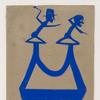

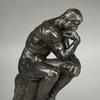

100x100_c.jpg)
